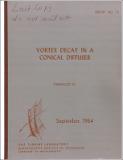| dc.contributor.author | So, Kwan-Lok | en_US |
| dc.contributor.other | General Electric Company | en_US |
| dc.contributor.other | General Motors Corporation. Allison Division | en_US |
| dc.contributor.other | Massachusetts Institute of Technology. Gas Turbine Laboratory | en_US |
| dc.date.accessioned | 2016-10-06T21:21:54Z | |
| dc.date.available | 2016-10-06T21:21:54Z | |
| dc.date.issued | 1964 | en_US |
| dc.identifier.uri | http://hdl.handle.net/1721.1/104677 | |
| dc.description | September 1964 | en_US |
| dc.description | Errata sheet inserted | en_US |
| dc.description | Includes bibliographical references | en_US |
| dc.description | Preliminary report | en_US |
| dc.description.abstract | The behavior of vortex flow in a conical diffuser has been studied in this report. The flow considered here is a steady, incompressible, axially symmetric one. The present experimental investigation has resulted in the establishment of five flow regimes. These regimes represent three basic types of rotating flow and two transitional phenomena. In Regime 1 the flow is a laminar, one-celled vortex. In Regime 3 the flow is also a one-celled vortex, but turbulent, In Regime 5 the flow is a turbulent, two-celled vortex. Regime 2 represents the transition of a one-celled vortex flow from laminar to turbulent. This transition is characterized by the formation of a bubble along the axis. Regime 4 shows another transitional phenomenon. This transition is the breakdown of a two-celled vortex into a one-celled vortex, but the character of this breakdown is still not fully explored. These regimes can be considered as the steps that the flow in the diffuser must go through as the flow rate or swirl is increased. The number associated with these regimes indicates the order of change from one regime to another. In Regimes 1,3, and 5, similarity in the velocity profiles does exist, but not in Regimes 2 and 4. For simplicity Regime 3 was selected as the basis for a theoretical model. The initial requirement that the total head in the outer region of the flow be conserved proved unsuccessful. When this condition was dropped in favor of the moment of axial momentum, a theoretical development at least qualitatively in agreement with the observed vortex decay is achieved. It is felt that the neglect of turbulent shear stresses in the analysis is largely responsible for the discrepancy that exists between theory and experiment. | en_US |
| dc.description.sponsorship | Under the sponsorship of General Electric Company, Allison Division of General Motors Corporation | en_US |
| dc.format.extent | 1 volume ([120] pages in various pagings) | en_US |
| dc.publisher | Cambridge, Mass. : b Gas Turbine Laboratory, Massachusetts Institute of Technology, [1964] | en_US |
| dc.relation.ispartofseries | GTL report #75 | en_US |
| dc.subject.lcc | TJ267.A1 M37 no.75 | en_US |
| dc.subject.lcc | QA925 .S6 1964 | en_US |
| dc.subject.lcsh | Vortex-motion | en_US |
| dc.subject.lcsh | Diffusers | en_US |
| dc.title | Vortex decay in a conical diffuser | en_US |
| dc.type | Technical Report | en_US |
| dc.identifier.oclc | 09162658 | en_US |
